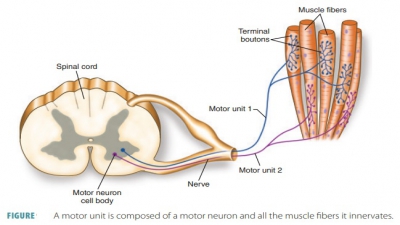Effects of Aging on Muscle Tissue
| Home | | Anatomy and Physiology | | Anatomy and Physiology Health Education (APHE) |Chapter: Anatomy and Physiology for Health Professionals: Support and Movement: Muscle Tissue
Nearly all types of muscle tissue develop from the embryonic mesoderm cells known as myoblasts, which fuse to form the myotubes of skeletal muscle fibers.
Effects of
Aging on Muscle Tissue
Nearly all types of muscle tissue
develop from the embryonic mesoderm cells known as myoblasts, which fuse to form the myotubes of skeletal muscle fibers. Skeletal muscle fibers begin
contracting at approximately the 7th week of embryonic develop-ment. The
somatic nervous system begins to control muscle fibers and the amount of fast
and slow con-tractile fibers is determined. Very early in the devel-opment, the
myoblasts that produce cardiac and smooth muscle cells develop gap junctions
instead of fusing. The satellite cells of skeletal muscle help to repair
injured fibers. They allow limited regenera-tion of dead skeletal muscles, but
this ability lessens with age. Cardiac cells only divide at a rate that is less
than other muscle types. When the heart mus-cle is injured, its repair usually
involves scar tissue. Smooth muscles regenerate well, with their cells dividing
continually throughout life.
Muscular development occurs in a
pattern, from head to toe and from proximal to distal directions. For example,
infants are able to lift their heads long before they can walk. Gross movements
develop before fine movements. By the middle of adolescence, humans reach total
neural control of their muscles, which can be improved by athletic activities.
Females’ skeletal muscles make up about 36% of their body mass. Males’ skeletal
muscles make up about 42%, which occurs because of the effects of testosterone.
In both sexes, however, body strength per unit of muscle mass is the same.
Strenuous exercise increases mus-cle enlargement in males more than females,
again because of testosterone. Skeletal muscle is highly resistant to infection
because of its rich blood supply.
Connective tissue in the skeletal
muscles increases with aging, yet the number of muscle fibers decreases.
Muscles are more sinewed (stringy) than before. By the age of 30, a gradual
loss of muscle mass begins, known as sarcopenia.
This atrophy of muscle is controlled by the same factors that influence muscle
growth: enzymes, hormones, transcription factors, and others. Skeletal muscle
fibers become smaller in diameter as the number of myofibrils decreases. Body
weight and muscle strength begin to decline as skeletal muscles form so much of
the body mass. Blood flow to active muscles does not increase as rapidly with
exercise.
By the age of 80, muscle strength
has usually decreased by half. This condition, called flesh wasting, is potentially dangerous to the elderly since they
expe-rience more falls. As the cardiovascular system ages, nearly all body
organs, including muscles, receive less nutrients. The development of
atherosclerosis often results in intermittent
claudication, a circulatory con-dition that restricts blood delivery. The
individual experiences severe leg muscle pain during walking and must rest more
often. However, regular exercise, even later in life, helps to reverse
sarcopenia. The use of weights helps to rebuild muscle mass and increase muscle
strength. Daily walking helps to improve neuromuscular function and overall
health. Smooth muscle experiences much less problems with aging.
Gastrointestinal smooth muscle continues to alter motility in order to cleanse
the body of irritants and infections.

